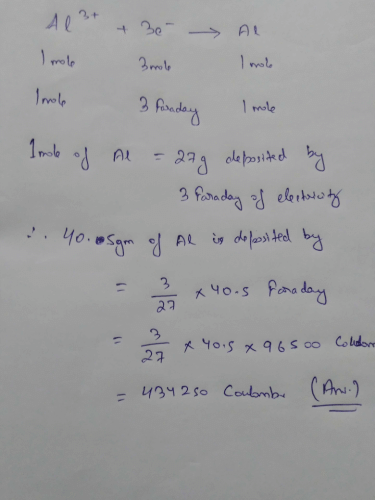NEET Exam > NEET Questions > Calculate the no. of electrons required to de...
Start Learning for Free
Calculate the no. of electrons required to deposit 40.5gm.of Al ?
Most Upvoted Answer
Calculate the no. of electrons required to deposit 40.5gm.of Al ?
Calculation of electrons required to deposit 40.5gm of Al
Introduction
Aluminum (Al) is a metal that is widely used in various industries due to its unique properties such as low density, high strength, and good conductivity. Electroplating is a process that is commonly used to coat a metal object with a thin layer of another metal, such as aluminum. In this process, a current is passed through a solution containing the metal ions to be deposited, and the metal ions are reduced to form a thin layer on the object. In this article, we will calculate the number of electrons required to deposit 40.5gm of aluminum using the Faraday's law of electrolysis.
Faraday's law of electrolysis
Faraday's law of electrolysis states that the amount of a substance deposited or liberated at an electrode during electrolysis is directly proportional to the quantity of electricity passed through the electrolyte.
The formula to calculate the amount of substance deposited is:
Amount of substance deposited = (Current x Time x Atomic weight) / (Number of electrons x Faraday's constant)
Where,
Current = the amount of electric current passing through the electrolyte (in amperes)
Time = the duration of electrolysis (in seconds)
Atomic weight = the atomic weight of the metal being deposited
Number of electrons = the number of electrons required to reduce one ion of the metal being deposited
Faraday's constant = 96,485 coulombs per mole of electrons
Calculation
In the case of aluminum, the atomic weight is 26.98 and the number of electrons required to reduce one ion of aluminum is 3. Therefore, the formula can be simplified as:
Amount of aluminum deposited = (Current x Time x 26.98) / (3 x 96,485)
To calculate the number of electrons required to deposit 40.5gm of aluminum, we need to rearrange the formula to solve for the current:
Current = (Amount of aluminum deposited x 3 x 96,485) / (Time x 26.98)
Assuming a current of 1 ampere and a time of 1 second, we can calculate the amount of aluminum deposited in grams:
Amount of aluminum deposited = (1 x 1 x 26.98) / (3 x 96,485) = 9.01 x 10^-5 g
Therefore, the number of electrons required to deposit 40.5gm of aluminum can be calculated as:
Number of electrons = (40.5 / 9.01 x 10^-5) x (3 x 96,485) = 1.02 x 10^23
Conclusion
In conclusion, the number of electrons required to deposit 40.5gm of aluminum using the Faraday's law of electrolysis is 1.02 x 10^23. This calculation shows the importance of understanding the principles of electroplating and the use of Faraday's law of electrolysis in various industries.
Community Answer
Calculate the no. of electrons required to deposit 40.5gm.of Al ?

Attention NEET Students!
To make sure you are not studying endlessly, EduRev has designed NEET study material, with Structured Courses, Videos, & Test Series. Plus get personalized analysis, doubt solving and improvement plans to achieve a great score in NEET.

|
Explore Courses for NEET exam
|

|
Similar NEET Doubts
Calculate the no. of electrons required to deposit 40.5gm.of Al ?
Question Description
Calculate the no. of electrons required to deposit 40.5gm.of Al ? for NEET 2024 is part of NEET preparation. The Question and answers have been prepared according to the NEET exam syllabus. Information about Calculate the no. of electrons required to deposit 40.5gm.of Al ? covers all topics & solutions for NEET 2024 Exam. Find important definitions, questions, meanings, examples, exercises and tests below for Calculate the no. of electrons required to deposit 40.5gm.of Al ?.
Calculate the no. of electrons required to deposit 40.5gm.of Al ? for NEET 2024 is part of NEET preparation. The Question and answers have been prepared according to the NEET exam syllabus. Information about Calculate the no. of electrons required to deposit 40.5gm.of Al ? covers all topics & solutions for NEET 2024 Exam. Find important definitions, questions, meanings, examples, exercises and tests below for Calculate the no. of electrons required to deposit 40.5gm.of Al ?.
Solutions for Calculate the no. of electrons required to deposit 40.5gm.of Al ? in English & in Hindi are available as part of our courses for NEET.
Download more important topics, notes, lectures and mock test series for NEET Exam by signing up for free.
Here you can find the meaning of Calculate the no. of electrons required to deposit 40.5gm.of Al ? defined & explained in the simplest way possible. Besides giving the explanation of
Calculate the no. of electrons required to deposit 40.5gm.of Al ?, a detailed solution for Calculate the no. of electrons required to deposit 40.5gm.of Al ? has been provided alongside types of Calculate the no. of electrons required to deposit 40.5gm.of Al ? theory, EduRev gives you an
ample number of questions to practice Calculate the no. of electrons required to deposit 40.5gm.of Al ? tests, examples and also practice NEET tests.

|
Explore Courses for NEET exam
|

|
Suggested Free Tests
Signup for Free!
Signup to see your scores go up within 7 days! Learn & Practice with 1000+ FREE Notes, Videos & Tests.

























